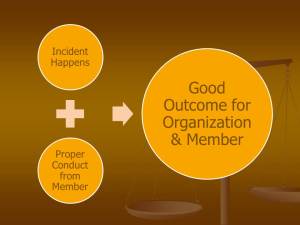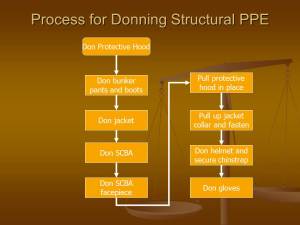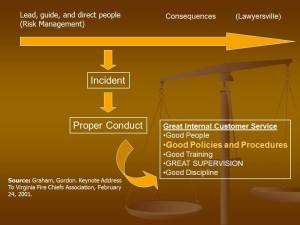By: Robert Avsec
Think there’s not a need for organizational risk management in Fire and EMS organizations? Take a look at some of the recent “ripped from the headlines” stories about firefighters and officers that have not done much to enhance the reputation and standing of our profession.
- Firefighters Charged With Massive Overtime Scam
- FBI sifts through 250,000 e-mails in firefighter sick-leave probe
- Woman Files Lawsuit Alleging Sexual Assault by Firefighters
- Sex Scandal Rocks Fire Department
- Firefighters Indicted for Theft in Pay Scandal
Reducing organizational risk starts with the leadership and guidance provided by the CEO (Fire Chief) and their leadership team (Chief Officers). It is the responsibility of those officers and civilian managers to constantly be “scanning the environment” in their shop to identify new areas of risk.
These specific areas of risk usually involve managers who “think they know the answer”, but really don’t, making high risk decisions on issues that they infrequently deal with, usually with negative consequences for the organization.
Once those specific areas of organizational risk are identified, The CEO and their team must proactively reduce the organization’s exposure to those risks using policies, procedures, processes and training to create an organizational environment that supports employee motivation and reduces organizational risk.
Gordon Graham lists Good Policies and Procedures as one of his “Five Pillars of Great Internal Customer Service” because he states:
You can’t do great external customer service unless you’re first doing great internal customer service.
(Click on any image below to enlarge)

Great internal customer services helps ensure that when an incident occurs, i.e., something happens that requires our people to make a decision or take action, those individuals will engage in proper conduct, i.e., they’ll make the right decision or take the correct action. Failure of proper conduct means consequences for the individual and the organization, i.e., a risk has become a liability (Source: Graham, G. Keynote Address, Virginia Fire Chiefs Association, 2/24/2001).
Organizational Risk Reduction Strategies
Size-up. Start by conducting an objective risk assessment for every job description within the organization. One cost effective methodology is to conduct focus groups—consisting of at least 5 incumbents for each position—to answer the question: “What do people doing this job get in trouble for doing?” Goal of the focus groups should be to identify the High Risk/High Frequency/Non-Discretionary Time tasks for their respective job positions.
Communicate. Developing an effective internal communications system is an essential risk reduction strategy. Create effective policies to provide strategic direction for all personnel so that personnel have clear direction regarding the Why and the What for their areas of job responsibility.
Tactics for Risk Reduction
- Policy
- Procedure
- Process
- Memorandum
From your strategies should “flow” effective procedures—which should answer the How and the Who questions—that provide direction for all personnel on what they need to do to comply with any particular policy. (A policy without a procedure that gives me direction for compliance gives me two options: (1) don’t follow the policy; and (2) do the job the way I want, which may or may not comply with policy. Either one is not good for the organization).
Related: See Curators of the Organizational Culture
Think of these communication tools as the constitution, laws, and regulations, i.e., the governing documents, for the organization just as the U.S. Constitution, federal and state and local laws, and regulations are the governing documents for our society. These tools can only be effective, however, if they are clearly written and all members are informed and educated about them.
The organization’s policies should be derived from the strategic planning process; policy statements should “link back” to specific parts of the Strategic Plan, e.g., the organization’s values, goals, or objectives.
Policy statements should clarify for the members of the organization What subject the policy is addressing and Why the organization needs this particular policy; the latter is the best place to describe the linkage between the policy and its applicable element in the strategic plan. Effective policies have the greatest influence on the attitudes of the members of the organization.
- Safety Policy
- Driving Policy
- Sexual Harassment Policy
- Uniform Policy
- Hiring Policy
Well-crafted policy statements should typically not exceed one page because they should be broad in scope. Because they are broad in scope, well-crafted policy statements should not require frequent revision unless the “driving force” behind the policy, e.g., the strategic plan or federal or state law, changes significantly and creates the need for policy revision. Example: changes in the application of the Fair Labor Standards Act (FLSA) by the Department of Labor forced many departments to alter their policies regarding career personnel volunteering for the same agency where they were employed.
Example Safety Policy
- We do not expose our people to unmanaged risks;
- We use the Incident Command System for all emergency incident operations;
- We use Respiratory Protection and PPE that is appropriate for the hazard;
- We use Risk Management processes in the management of emergency incidents; and
- We will risk a lot to save a life, risk a little to save property, and risk nothing to save nothing.
Procedures provide the link to organizational policies and they provide direction to members of the organization on How to properly comply with policy.
Unlike policies, procedures should undergo regular reassessment to keep them current with “outside influences” such as:
| Source | Type of Influence |
| Federal and State Laws | CFR 1910.130
FLSA |
| Federal and State Regulations | OSHA
Centers for Disease Control |
| Standards | NFPA Standards
Financial management and Accounting Standards |
| Local Ordinances | Building Code (Adopted)
Fire Prevention Code (Adopted) |
| New Technologies | Class A foam
Lightweight building construction materials |
Processes “drill down further” and provide the published directions for complying with procedures. Processes are essential for any task when:
- The task is done repeatedly;
- The task is performed by multiple people; and
- Consistent outcomes are essential regardless of who does the task.
 The necessity of processes takes on a whole new importance when it comes to the training of new personnel in task completion. Processes help ensure the uniformity of entry-level training and maintain the congruence of what the new employee is learning with expected performance once in the field
The necessity of processes takes on a whole new importance when it comes to the training of new personnel in task completion. Processes help ensure the uniformity of entry-level training and maintain the congruence of what the new employee is learning with expected performance once in the field
(In my former department, Chesterfield County (VA) Fire & EMS our Training and Safety Division Motto was, Training Teaches What Operations Does and Operations Does What Training Teaches).
So how do your organization’s risk reduction tools compare?
 Fire & EMS Leader Pro The job of old firefighters is to teach young firefighters how to become old firefighters!
Fire & EMS Leader Pro The job of old firefighters is to teach young firefighters how to become old firefighters!

